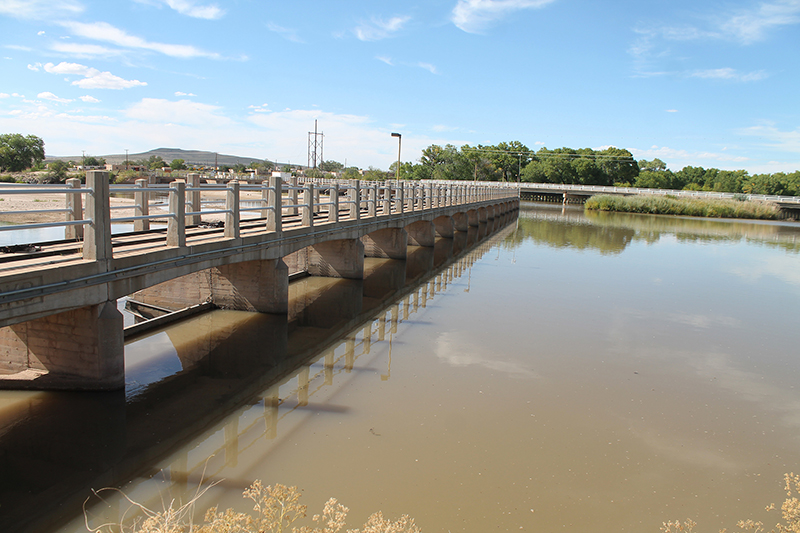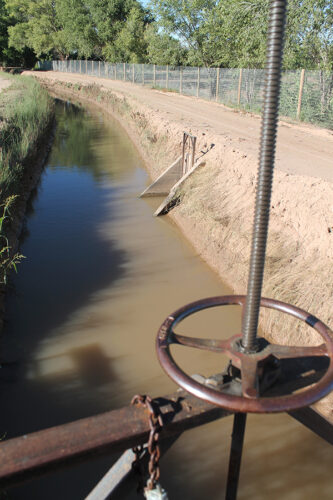The Rio Grande — whether it is running beyond capacity and overbanking into the bosque or a muddy trickle through the sand — is a green heart line through the valley, feeding the thriving arterial system that is the irrigation ditches.
Those ditches carry water to the fields of farmers who have been here for generations. The water not used to nourish crops either seeps down and replenishes the aquifer beneath us or is returned to the river through a system of drains and is taken further south to once again be diverted to agriculture.
This system of canals, ditches and drains — 505 miles alone in Valencia County, irrigating about 30,000 acres — is operated and maintained by the Middle Rio Grande Conservancy District.
Looking back to look forward
In order to look at the future of irrigation in the district, Jason Casuga, MRGCD CEO and chief engineer, says you have to look back and understand the underlying reasons the district was created.
“At the turn of the 1900s, there was a desire to ‘reclaim’ the west. The idea was, the population needed to move out west but to make that possible you needed some kind of reclamation service. That was kind of the birth of the (United States) Bureau of Reclamation,” Casuga said. “One thing folks knew was they would need to grow food to live out here, and to grow food, you need water.”
In 1923, the state established the MRGCD, which runs from Cochiti Pueblo south to Elephant Butte Lake through four counties — Sandoval, Bernalillo, Valencia and Socorro. The district was given three main priorities — control river flooding, groundwater drainage and irrigation.
By the 1950s, levees and additional infrastructure from the BOR had helped tame the river.
At one point, there were 72 different diversion points throughout the district on the river to move water into the ditch system, but that was eventually consolidated to four — Cochiti, Angostura, Isleta, and San Acacia — and from those four diversion points a system of canals was built to connect historical irrigation ditches and acequias with new facilities.
“That’s the backbone of the system,” Casuga said. “We divert water, deliver it to farms, and the water not delivered goes into drains and back into the river. Groundwater is vacated and drained by those same drains and goes into the river. Then it’s rediverted at the next diversion downstream. That’s how the water makes its way down the valley. About 95 percent of the system is operated by gravity.”
Now nearly 100 years later, Casuga said the district has many modern elements in its irrigation system, the most impactful being the ability to measure flows more accurately.
“It’s widely said, ‘If you can’t measure it, you can’t manage it,’” he said. “Now that we have a good idea of what we’re using, we have to look at how efficient we are in our delivery.”
Efficiency is dependent on a system that is well maintained and the district’s infrastructure has reached a literal breaking point. For at least two years, the district has been deficit spending — something Casuga said outside of the federal government is frowned upon — and infrastructure has suffered due to lack of timely maintenance.
In May, the MRGCD Board of Supervisors unanimously approved a 1 mill increase to property taxes throughout the district, which is expected to generate $4.3 million a year and will be dedicated solely to infrastructure projects. The increase will make its first appearance on property tax bills going out in November.
“A lot of folks were frustrated and upset. They want the infrastructure and the benefits it brings but we struggle to pay that bill,” Casuga said. “This system has thrived for almost 100 years and we’re focusing on the wrong thing if we’re focusing on the fact we have to raise taxes. If you like the system, like the river that we have and agriculture we have, why are we upset when we have to maintain the system?”
Part of the infrastructure conversation is looking at whether to line more channels and ditches with concrete, to help prevent erosion and keep water moving at a better rate.
Typically, the agricultural land the district serves is south of urban areas, Casuga said, especially the areas north of the Bernalillo and Isleta diversion dams.
“We have to divert and safely move water through those urbanized areas to ag lands,” he said. “Culturally, ditches along the Rio Grande have been earthen. You have vegetation that comes up and the net positive is you have a lot of green. As you get away from the river and irrigation, you have less green.
“We have to balance efficiency with where we are culturally in the valley. I don’t think we should, nor would the public accept, turning most of the ditches to concrete. I don’t think it’s where we want to go as a valley.”
First in use, first in right
Well before the district existed, before Spanish colonization, there were — and still very much are — the indigenous water users of New Mexico. In the valley are the six Middle Rio Grande Pueblos, of which Isleta Pueblo is one. Under western water law, the idea of “first in use, first in right,” is typical, Casuga said.
“Prior use doctrine basically says who ever has been using the water has the right to continue using it,” he said. “If you take that and apply it to Indian land, you have your first users, who are the tribes.”
The six Pueblos have what are referred to as “prior and paramount” water rights for use on 8,847 acres of historically irrigated land.
“We share water shortages among all water users up until the point we can’t support them. If we get to that point, we have to curtail nontribal users to deliver water to prior and paramount lands. They are the last ones to irrigate before we run out,” Casuga said. “I think the people in the valley know (Pueblos) are the senior users. Among farmers, that is widely understood, especially in Valencia County.”
With a background in farming and ranching, Blane Sanchez, a member of Isleta Pueblo and the first New Mexico tribal member to sit on the New Mexico Interstate Stream Commission from 2003 to 2019, said water and irrigation use in certain stream systems in the state hinges on settling the first inhabitants future water needs.
“This is a particularly important point as the majority of the tribes in New Mexico have not quantified their water rights and that can take decades to resolve, let alone fully fund,” Sanchez said. “Despite efforts to reduce tribal water claims, it is acknowledged that the Rio Grande Pueblos have the most senior rights.
“Any quantity claimed will have push back as it will affect non-tribal uses. However, the non-tribal public should be supportive of Indian water rights settlements as they are direct and indirect beneficiaries.”
Sanchez named the Navajo-Gallup Pipeline and Pojoaque Basin Regional Water System as two water projects that, while driven by the needs of Native communities, benefit nonnatives as well.
The Navajo-Gallup project will provide a reliable municipal and industrial water supply to the eastern section of the Navajo Nation, southwestern portion of the Jicarilla Apache Nation and the city of Gallup, and the Pojoaque Basin system will bring clean drinking water to about 10,000 residents of the Pueblos of Pojoaque, Nambé, San Ildefonso and Tesuque, as well as some residents of Santa Fe County.
River health
In terms of sustainable irrigation in the Middle Rio Grande Valley, Sanchez, who’s 30 years of professional work and experience includes the areas of water quality standards, environmental protection, tribal and state water policy and water utilities administration, said it will depend on supply and demand, and any negative impacts resulting from projected climate change.
“Improving and enhancing infrastructure is key to distributing available supply but it is also critical to administer and account for water distribution with increasing population and economic development demands,” he said.
He continued, saying maintaining surface water quality is integral for irrigation sustainability especially when less supply cannot dilute pollution inflows.
“For the Isleta westside irrigation supply, it is diverted at Angostura Diversion north of Bernalillo, and must travel over 30 miles picking up return drain flows to augment supply,” he noted. “This length of travel contributes to potential water quality decline, particularly E.coli.”
In July 2022, a sewage system overflow by the Albuquerque Bernalillo County Water Utility Authority occurred during a time when the river was drying. That untreated sewage overflow into the Rio Grande degraded river water quality downstream of the Interstate 40 bridge, affecting human and aquatic health, Sanchez said.
“That same degraded water quality negatively affected the Pueblo’s eastside farmland below Isleta Diversion Dam and downstream off the reservation. Isleta’s tribal administration issued a public health advisory not to access, fish or enter the river. In coordination with the Middle Rio Grande Conservancy District, diversion was halted at (the Isleta dam) during a critical irrigation round with a dwindling water supply.”
Kateri Jojola, co-manager for Pueblo Resurgents, a community-governed organization committed to promoting anticolonial indigenous agroecology and resurgence within Isleta, was one of the Isleta farmers negatively impacted by the sewage spill.
“We were very worried, because it was raw sewage, the amount of heavy metals going into the soil (via irrigation water). We know that heavy metals accumulate and then can be transferred into food,” Jojola Said. “We took the precaution and decided not to use any of the irrigation water.”
On the eight acres she farms, which was farmed by her grandparents and her father, most of her crops were lost.
“These ecological and environmental stressors can be very challenging to deal with,” she said.
Calling farming the “cultural identity” of the Pueblos, Sanchez said a healthy river and water system are integral to agriculture and irrigation.
That identity is part of the entire valley and can be easily seen in the historic community of Tomé. Lifelong farmer Fabian Padilla says the role of agriculture in the valley is a historic one and interconnects with all parts of life. To those unfamiliar with flood irrigation, a field covered in water might seem like a waste of a precious resource, but Padilla says it’s anything but.
The grass he grows feeds meat animals that, in turn, feed people, and any water not used by the crops goes back to the aquifer and feeds the local water table.
“In the ’70s, you could dig 3 feet and hit water or at least moist soil. Now, you have to go 6 or 7 feet,” Padilla said. “We’re accused of using too much water and that comes from the rhetoric developers are putting out. The truth is, every time a farmer irrigates, they replenish the aquifer.”
Whether it’s commercial bottling companies, luxury subdivisions taking over farmland or a need for water in the river to keep an endangered species afloat, there always seems to be more needs than water, he said.
“These are the issues we’ve dealt with for years and years and years,” Padilla said. “There doesn’t seem to be an end to it because people want (farmers) out and we’re trying like hell to hang on. Even if you leave, there’s something here that draws you back to the land. A connection.”
Julia M. Dendinger began working at the VCNB in 2006. She covers Valencia County government, Belen Consolidated Schools and the village of Bosque Farms. She is a member of the Society of Professional Journalists Rio Grande chapter’s board of directors.





















